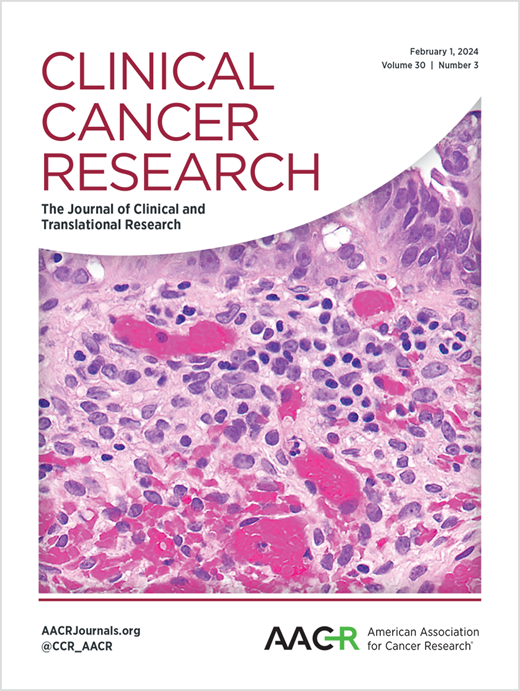Extracellular matrix-myCAF signatures correlate with resistance to neoadjuvant aPD-L1 immune checkpoint inhibition with durvalumab + metformin in HPV+ HNSCC.
IF 10.2
1区 医学
Q1 ONCOLOGY
引用次数: 0
Abstract
BACKGROUND Immune checkpoint inhibitors (ICI) have demonstrated clinical benefit in head and neck squamous cell carcinoma (HNSCC); however, single-agent efficacy is limited, leaving significant unmet needs. Metformin may synergize with ICI, offering promise to improve response rates. We leveraged multi-omic data from a randomized, presurgical neoadjuvant trial (NCT03618654) evaluating a single infusion of the anti-programmed death ligand 1 (PD-L1) ICI, durvalumab, with or without daily, standard dose metformin in previously untreated, non-diabetic patients with HNSCC to understand predictors of response and the effect of combination therapy. METHODS Clinical, pathological, and correlative data were analyzed to investigate response and resistance mechanisms. We present an in-depth multi-omic analysis of primary tumor specimens to study treatment response/resistance in HPV+ HNSCC. RESULTS Baseline samples revealed that myofibroblastic cancer-associated fibroblast (MYCAF) and extracellular matrix (ECM) signatures were enriched in durvalumab plus metformin (DM) nonresponders which were localized to the leading tumor edge on spatial transcriptomics. In contrast, baseline responder samples were enriched for the Langerhans-like dendritic cell (DC) state and interferon (IFN) signatures. Treatment increased intratumoral CD8+ T cell and IFN signatures and peripheral blood CCL2 levels. Responders demonstrated macrophage and dendritic cell enrichment and antigen processing and presentation upregulation. Enrichment of cell cycle-related gene sets, specifically the MYC targets V1 Hallmark gene set, correlated with nonresponse. CONCLUSION Early response and resistance dynamics for DM in HPV+ HNSCC reveal baseline ECM-MYCAF as predictive of nonresponse. In contrast, responders were distinguished by baseline enrichment in the Langerhans-like DC cell state and post-treatment antigen-presenting gene sets.在HPV+ HNSCC中,细胞外基质- mycaf特征与durvalumab +二甲双胍对新辅助aPD-L1免疫检查点抑制的耐药性相关。
免疫检查点抑制剂(ICI)在头颈部鳞状细胞癌(HNSCC)中的临床疗效已得到证实;然而,单药疗效有限,留下了大量未满足的需求。二甲双胍可能与ICI协同作用,有望提高反应率。我们利用了一项随机的手术前新辅助试验(NCT03618654)的多组学数据,评估了先前未经治疗的非糖尿病HNSCC患者单次输注抗程序性死亡配体1 (PD-L1) ICI, durvalumab,每日标准剂量二甲双胍或不每日标准剂量二甲双胍,以了解反应的预测因素和联合治疗的效果。方法分析临床、病理及相关资料,探讨耐药机制。我们对原发肿瘤标本进行了深入的多组学分析,以研究HPV+ HNSCC的治疗反应/耐药性。基线样本显示,在杜伐单抗加二甲双胍(DM)无应答者中,肌成纤维细胞癌相关成纤维细胞(MYCAF)和细胞外基质(ECM)特征丰富,这些特征在空间转录组学上定位于肿瘤边缘。相比之下,基线应答样本富集了朗格汉斯样树突状细胞(DC)状态和干扰素(IFN)特征。治疗增加了肿瘤内CD8+ T细胞和IFN特征以及外周血CCL2水平。应答者表现出巨噬细胞和树突状细胞富集,抗原加工和呈递上调。细胞周期相关基因集的富集,特别是MYC靶V1贺曼基因集,与无应答相关。结论:在HPV+ HNSCC中,DM的早期反应和耐药动态显示基线ECM-MYCAF可预测无反应。相比之下,应答者通过langerhans样DC细胞状态和治疗后抗原提呈基因组的基线富集来区分。
本文章由计算机程序翻译,如有差异,请以英文原文为准。
求助全文
约1分钟内获得全文
求助全文
来源期刊

Clinical Cancer Research
医学-肿瘤学
CiteScore
20.10
自引率
1.70%
发文量
1207
审稿时长
2.1 months
期刊介绍:
Clinical Cancer Research is a journal focusing on groundbreaking research in cancer, specifically in the areas where the laboratory and the clinic intersect. Our primary interest lies in clinical trials that investigate novel treatments, accompanied by research on pharmacology, molecular alterations, and biomarkers that can predict response or resistance to these treatments. Furthermore, we prioritize laboratory and animal studies that explore new drugs and targeted agents with the potential to advance to clinical trials. We also encourage research on targetable mechanisms of cancer development, progression, and metastasis.
 求助内容:
求助内容: 应助结果提醒方式:
应助结果提醒方式:


